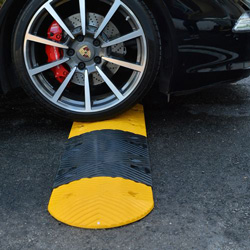Comparison with traditional speed bumps
When compared to traditional speed bumps, rubber speed bumps offer several advantages. Firstly, rubber speed bumps are more durable and long-lasting than their concrete or asphalt counterparts. They are also easier to install and remove, making them a more cost-effective option. Rubber speed bumps are also more effective at slowing down traffic, as they are designed to be wider and lower than traditional speed bumps, which can cause discomfort to drivers and passengers. Additionally, rubber speed bumps are less likely to damage vehicles, as they are made from a softer material that absorbs impact. Overall, rubber speed bumps provide a safer and more efficient solution for traffic calming.
Comparison with speed humps
While rubber speed bumps and speed humps may seem similar, there are some key differences between the two. Speed humps are typically larger and wider than speed bumps, and they are designed to slow down traffic over a longer distance. This can be beneficial in areas where there are frequent accidents or where speeding is a major problem. However, speed humps can also be more expensive to install and maintain than speed bumps. Additionally, speed humps may not be as effective at slowing down traffic in areas where drivers are more likely to ignore them. Overall, the choice between speed bumps and speed humps will depend on the specific needs of the area and the goals of the traffic calming program.
Comparison with chicanes
While chicanes are also a popular traffic calming measure, they may not be as effective as rubber speed bumps in certain situations. Chicanes require drivers to navigate through a series of curves, which can be difficult for larger vehicles such as buses and trucks. Additionally, chicanes may not be as visible as speed bumps, which can lead to drivers not slowing down in time. Rubber speed bumps, on the other hand, are highly visible and provide a clear indication to drivers to slow down. They are also easier to install and maintain compared to chicanes, making them a more cost-effective solution for traffic calming.
Comparison with roundabouts
While roundabouts are also effective in traffic calming, they require a larger area and more expensive construction. Rubber speed bumps, on the other hand, are cost-effective and can be easily installed in any location. Additionally, speed bumps are more visible to drivers, making them a better option for areas with high pedestrian traffic. Overall, while roundabouts may be a better option for larger intersections, rubber speed bumps are a practical and efficient solution for smaller roads and parking lots.
Case Studies
Case study 1: Implementation of rubber speed bumps in a residential area
In a residential area in California, rubber speed bumps were implemented to address speeding concerns. The speed bumps were installed on a road that had a history of accidents and speeding violations. After the installation of the speed bumps, the average speed of vehicles decreased significantly, and there was a noticeable reduction in the number of accidents. The residents also reported feeling safer and more comfortable walking and cycling on the road. The implementation of rubber speed bumps proved to be an effective solution for traffic calming in this residential area.
Case study 2: Implementation of rubber speed bumps in a school zone
In another case study, rubber speed bumps were implemented in a school zone to improve safety for children. The speed limit in the area was reduced to 20 mph, but many drivers still exceeded this limit. The installation of rubber speed bumps helped to slow down traffic and reduce the risk of accidents. Parents and school staff reported feeling more at ease with the increased safety measures, and the local community praised the initiative. The use of rubber speed bumps in school zones has become increasingly popular due to their effectiveness in reducing speed and improving safety for children.
Case study 3: Implementation of rubber speed bumps in a commercial area
In a commercial area in downtown Los Angeles, the implementation of rubber speed bumps has proven to be highly effective in reducing speeding and improving safety for both pedestrians and drivers. The speed bumps were strategically placed in areas with high foot traffic, such as crosswalks and intersections, and have significantly reduced the number of accidents and near-misses. Additionally, the rubber material of the speed bumps has reduced noise pollution and minimized damage to vehicles, making them a cost-effective and environmentally friendly solution for traffic calming in urban areas.
Conclusion
Future research and development
Future research and development in the field of rubber speed bumps for traffic calming is essential to ensure their continued effectiveness and safety. One area of focus could be on developing new materials that are even more durable and resistant to wear and tear. Additionally, research could be conducted on the optimal placement and spacing of speed bumps to maximize their effectiveness without causing discomfort or damage to vehicles. Finally, studies could be conducted on the long-term effects of speed bumps on traffic patterns and driver behavior to better understand their overall impact on road safety. By continuing to invest in research and development, we can ensure that rubber speed bumps remain a valuable tool for traffic calming and accident prevention.
Next Steps: If you’re interested in implementing rubber speed bumps for traffic calming in your community, consider purchasing from Unimat Industries. Their selection of high-quality speed bumps are durable, easy to install, and effective in slowing down traffic. Visit their website at https://unimatindustries.com/product-category/speed-bumps/ to browse their selection and make a purchase. By taking this step, you can contribute to creating safer and more peaceful streets for everyone.


